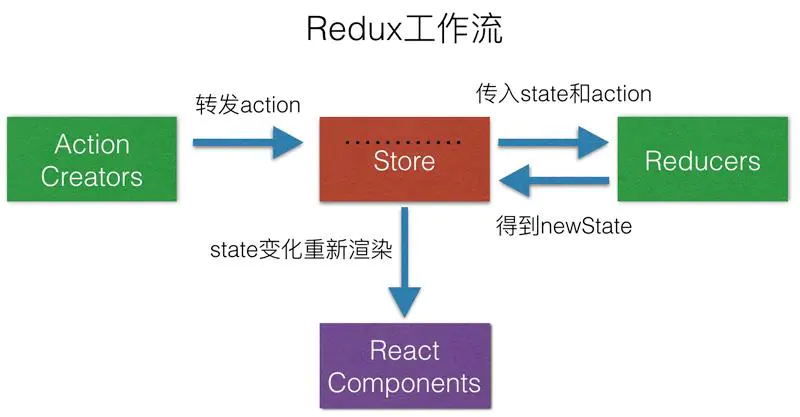Redux 原理和简单实现
前端开发中React + Redux 是大部分项目的标配,Redux也是我喜欢的库之一,他的源码也拜读过几遍,每次都有很多收获,尤其他的中间件设计模式,对自己封装一些库提供了思想上的指导。
Redux工作流程如下图:

代码实现
<!DOCTYPE html> <html lang="en"> <head> <meta charset="UTF-8"> <title>Title</title> </head> <body> <script> function compose(middlewares) { // 相当于fn1(fn2(fn3(...ages))) // 所以中间件是从右到左执行 return middlewares.reduce((a, b) => (...args) => a(b(...args))); } function createStore(reducers, middlewares) { const currentState = {}; let dispatch = function (action) { Object.keys(reducers).forEach(function (key) { currentState[key] = reducers[key](currentState[key], action); }) } function getState() { return currentState; } if (middlewares) { // 通过闭包,把当前的dispatch, getState传递到中间件中 // (action, ...args) => dispatch(action, ...args) 这里需要使用函数实时获取dispatch, 可以理解为next等价 const chain = middlewares.map(middleware => middleware((action, ...args) => dispatch(action, ...args), getState)) // 传递dispatch标识next dispatch = compose(chain)(dispatch); } dispatch({type: 'INIT'}); return { dispatch, getState } } // log 中间件 function logMiddleware(dispatch, getState) { return function (next) { return function (action) { console.log(`当前的age: ${getState().userInfo ? getState().userInfo.age : null}, 将要更新age为:${JSON.stringify(action)}`); return next(action); } } } // thunk 中间件可以异步请求 function thunkMiddleware(dispatch, getState) { return function (next) { return function (action) { if (typeof action === 'function') { return action(dispatch, getState); } return next(action); } } } const store = createStore({ userInfo: function (prevState = {age: 1, name: 'initName'}, action) { switch (action.type) { case 'SET': return {...prevState, ...action.value}; default: return prevState; } } }, [thunkMiddleware, logMiddleware]); console.log('init', store.getState().userInfo.name, store.getState().userInfo.age); store.dispatch({type: 'SET', value: {age: 18}}); store.dispatch(function (dispatch, getState) { // 模拟异步请求 setTimeout(function () { dispatch({type: 'SET', value: {age: getState().userInfo.age + 1}}) }, 2000); }); console.log(store.getState().userInfo.name, store.getState().userInfo.age); store.dispatch({type: 'SET', value: {name: 'xiaoLi'}}); console.log(store.getState().userInfo.name, store.getState().userInfo.age); setTimeout(function () { console.log(store.getState().userInfo.name, store.getState().userInfo.age); }, 2000); </script> </body> </html>



